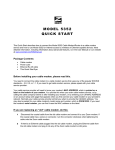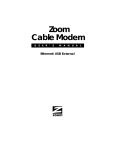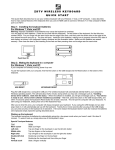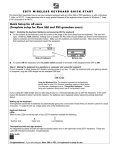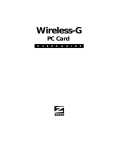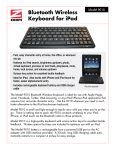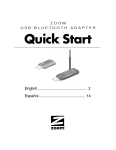Download Zoom Ethernet User manual
Transcript
If you want to connect the modem/router wirelessly to a Wi-Fi compatible device, see Connecting the Cable Modem/Router Wirelessly to Some Device. If you want to connect additional computers/devices using the modem/router’s Ethernet/LAN ports, please see Read This Only if You Are Connecting Additional Computers and/or Other Devices to the Cable Modem/Router’s Ethernet ports. If you want to configure advanced options, please refer to the User Manual on our website at www.zoomtel.com/5352manual CABLE MODEM/ROUTER WITH WIRELESS-N QUICK START This Quick Start describes how to connect the Model 5352 Cable Modem/Router to a cable modem service and how to use Model 5352 for Internet access by wireless or Ethernet-capable devices. More detailed information, including information about advanced features, is in the User Manual on our website at www.zoomtel.com/5352manual Package Contents Cable modem/router Power cube Ethernet cable Setup if you don’t use a cable modem starter kit 1 2 Before Installing Your Cable Modem/Router Your cable service provider needs to know your modem's CM-MAC ADDRESS, which is printed on a label on the bottom of your modem. You can provide this when you order cable modem service; or if you already ordered service, by calling the cable company BEFORE installing your modem. You may also be asked for your cable modem's model name and number, which is ZOOM 5352. If you need the modem's serial number, you can find it near the MAC address on the label. System Requirements • You need to connect the cable modem/router to a cable modem service that uses any of the popular DOCSIS standards – 3.0, 2.0, or 1.1. If you need to get cable modem service, please speak with your cable service provider. • To access the Internet, you need a computer, tablet, or smartphone that has either an Ethernet port or Wi-Fi compatible wireless capability. If your cable service provider supplied a cable modem starter kit, please continue below. If you don’t have or choose not to use the cable modem starter kit from your service provider, please go to Setup if you don’t use a cable modem starter kit. 3 Be sure your computer is on and the cable modem is unplugged. Note: Please refer to the Hardware Connection section if you would like to see a diagram of the back of the cable modem and a description of the connections as you read the following steps. If there’s a plastic cap on the RF connector at the back of the cable modem, remove the cap. Connect and securely fasten the coaxial cable onto the round, silver RF connector. If the other end of the coaxial cable is loose, connect that end securely to a cable outlet or splitter. You can connect a coaxial cable between an open cable service wall jack and the cable modem. (If no wall jack is available, you can use a coaxial T connector or splitter to share an existing connection with a TV, for example.) Alternatively, there may already be a coaxial cable that is connected to service and that has an open end for connecting to the cable modem. Plug the power cube into the POWER connector on the rear panel of the cable modem and into an electrical outlet. Make sure the On/Off switch on the back of the cable modem is on. The cable modem/router should go on with the Power LED lit up. Note: It normally takes 5 to 30 minutes to establish an Internet link the first time a cable modem/router connects to a cable service provider. This allows the cable modem to connect to the appropriate channels for communication. You’ll see the DS, US, and/or Online modem lights on your cable modem flashing until the Online light stays steady green to signal success. If your cable service provider provided a cable modem starter kit Some cable service providers supply a cable modem starter kit that can be useful when you install your cable modem. The kit may include a coaxial cable for connecting between a wall jack and your cable modem. (These are also available at most electronics retailers.) The kit will include instructions, and may also include a CD with software. If you receive a kit like this, we recommend that you read the kit’s instructions and use them to install your Zoom cable modem/router. This modem is a DOCSIS 3.0 modem/router certified by CableLabs, and connects like a normal cable modem. You will need to plug in the modem’s power cube, connect to cable modem service using a coaxial cable, and then connect to a computer, tablet, or smartphone using either the included Ethernet cable or Wi-Fi compatible wireless capability. (See Using the Cable Modem/Router to Make a Wireless Connection). Note: Please refer to the Hardware Connection section if you would like to see a diagram of the back of the cable modem and a description of the connections. You will probably need to take a plastic cap off the RF connector. After you have installed your cable modem and it has synchronized itself with the cable network, your cable modem can connect your computers, tablets, smartphones and other WiFi compatible or Ethernet-enabled devices to the Internet. Note: It normally takes 5 to 30 minutes to establish an Internet link the first time a cable modem/router connects to a cable service provider. This allows the cable modem to connect to the appropriate channels for communication. You’ll see the DS, US, and/or Online modem lights on your cable modem flashing until the Online light stays steady green to signal success. Now open the browser of a device connected through a cable or wirelessly to your modem/router. If the browser works, your cable modem is working! Hardware Connection 4 Check to make sure you have Internet access. If you have a computer, connect the modem’s Ethernet cable to any Ethernet port (LAN 1, 2, 3, or 4) on the rear panel of the cable modem/router and connect the other end to an Ethernet port on your computer. Now open your browser and go to a familiar Web site to check that the cable modem is working. If it is, your cable modem is ready for use! Whether or not you have a computer, you can connect wireless or Ethernet devices to the Internet through your working modem/router. For Internet access using a smartphone, tablet, or other wireless device, see Connecting the Cable Modem/Router Wirelessly to Some Device. If you want to connect additional computers or other devices using the modem/router’s Ethernet/LAN ports, please see Read This Only if You Are Connecting Additional Computers and/or Other Devices to the Cable Modem/Router’s Ethernet ports. If you want to configure advanced options, please refer to the User Manual on our website at www.zoomtel.com/5352manual Please note the following: Do not block the modem/router vents in any way. Do not use the modem/router where it’s very hot or very cold. The modem/router can be horizontal or vertical. To put the cable modem/router in a vertical orientation, use the swiveling “foot” at the bottom of the unit. LAN 1-4 (Gigabit Ethernet 1-4) DESCRIPTION Four 10/100/1000 auto-sensing Ethernet ports for computers and other devices that have an Ethernet port. RESET Press and hold this recessed button at least 8 seconds in the unlikely event that you want to restore the default factory settings. This button is recessed to prevent accidental resets of your cable modem/router. RF / Cable Connect your coaxial cable line to this port. POWER ON/OFF SWITCH Connect the supplied power cube to this port. Powers the cable modem/router on or off. Connecting the Cable Modem/Router Wirelessly to Some Device A Wi-Fi compatible computer, smartphone, game station, or other device can access the Internet wirelessly through the Cable Modem/Router. You can connect up to 253 devices wirelessly. To make the wireless connection, follow these steps: 1 First locate the wireless connection setup on your device, and then select the cable modem/router network with the same name as the SSID name on the bottom of your cable modem/router. For example, on Windows computers, click the wireless connection icon on the Task Bar, click Available Wireless Networks, select the correct SSID from the list of available wireless networks, and then click the Connect button. 2 Next you will be prompted to enter the Security Key or Password for your wireless network. The WPA/WPA2 security key is printed on the bottom label of your cable modem/router. Cable Modem Bottom Label: 3 Open your device’s browser and go to a website to test your wireless setup. If it works, congratulations! If it doesn’t, please see the Troubleshooting Tips in the User Manual on the CD. Note: If you want to change the default SSID or the Security Key, please refer to the User Manual on our website at www.zoomtel.com/5352manual Read This Only if You Are Connecting Additional Computers and/or Other Devices to the Cable Modem/Router’s Ethernet/LAN Ports You can plug up to four computers, game consoles, or other Ethernet-capable devices into the cable modem’s LAN ports. For information about your specific device, please refer to the documentation that came with that device. Follow the instructions on the other side of this Quick Start for each computer or other device. 1 If you connected the cable modem to a computer using a wired connection when setting up the cable modem, unplug the computer now if you don’t want it to stay connected to the cable modem. 2 To connect a computer or other Ethernet-capable device, plug one end of an Ethernet cable into an available Ethernet (LAN 1, 2, 3, or 4) port on the cable modem and plug the other end of the Ethernet cable into the Ethernet port of the additional device you want to connect to the cable modem. (If you are connecting a hub or a switch, this is typically called an Uplink or Expansion port.) If you are connecting a computer or game station, go to step 5 of this section. 3 If you are connecting a network device such as a switching hub, use the instructions that came with that device. Then reboot any computer that is part of your network. For example, if you connected a switching hub, reboot any computer that will make a wireless connection to that switching hub. 4 If you are connecting a HomePlug adapter pair with one adapter plugged into the cable modem and an AC outlet, and the other adapter plugged into a computer or game station and an AC outlet, make those connections and then go to step 5. 5 Verify that your Internet connection is working. Open a Web browser on each computer that’s using your network and try to connect to a familiar Web address. Note: If at any time you need to make changes to the cable modem’s configuration, open a web browser from any PC on your cable modem’s network and type http://192.168.0.1 to open the Zoom Configuration Manager. Alternately, you can connect a computer directly to the cable modem, open its browser, and then type http://192.168.0.1. Congratulations! You have connected an additional device to the Internet. You can connect up to 4 Ethernet-capable devices to the cable modem/router, following the instructions above for each device and starting at step 2 of this section. Gaming If you are using your cable modem for gaming, you may need to make changes to the cable modem’s Advanced configuration page for the game to work. This can be done by setting up a DMZ or using port triggering. Please see the User Manual on the CD to decide which option to select and instructions on setting it up. Advanced Features You can configure advanced features after logging in to the Zoom Configuration Manager. Go to the section Logging in to the Zoom Configuration Manager. Then refer to the User Manual on our website at www.zoomtel.com/5352manual for information about all the options on the cable modem/router menu. Logging in to the Zoom Configuration Manager Step 1: Connecting the Cable Modem/Router to a Computer 1 Connect the router to a computer following the instructions under How to connect to a computer if you don’t have or choose not to use a cable modem starter kit. Then continue to Step 2 below. Step 2: Establishing Communication 1 Open your Web browser, enter http://192.168.0.1 in the address bar, and press the Enter key to open the Cable Modem/Router configuration software. 2 3 In the login dialog box, type the following User Name and Password in lower case, then click OK. User Name: admin Password: admin The Status page should appear. If the Status page doesn’t appear, please see Troubleshooting Tips. From the Zoom Configuration Manager, you can configure advanced features and make changes to the default wireless security options including the SSID and PreShared Key. Please refer to the User Manual on the CD for instructions. Front Panel LEDs Your Zoom cable modem has several lights on its front panel to help you monitor the cable modem/router’s status. LIGHT WPS COLOR Green WLAN Green LINK 1-4 Ethernet LAN ports Green or Amber Online Green DS Downstream sync Green or Blue US Upstream sync Green or Blue DS & US Blue Power Green DESCRIPTION Blinking: WPS is in discovery mode (LED blinks for up to 2 minutes) ON: LED lit solid for 30 seconds after WPS configuration is successful OFF (after 2 minutes blinking): No Wi-Fi client associated with the cable modem/router via WPS Blinking: Data is flowing ON: Wi-Fi is enabled OFF: Wi-Fi is not enabled Blinking: Data is flowing Green: Connected at highest LAN speed, 1 Gbps Amber: Connected at 10 or 100 Mbps OFF: No Ethernet link detected Blinking: Cable interface is acquiring IP, Time of Day, and configuration ON: Cable modem/router is online OFF: Cable modem/router is offline Blinking: Scanning for DS channel Green ON: Synchronized on 1 channel only Blue ON: Synchronized with more than 1 channel (DS Bond mode) Blinking: Ranging is in progress. Green: Ranging is complete; operate on 1 channel Blue: Ranging is complete; operate on more than 1 channel (US Bond mode) OFF: Upstream channel is inactive Both DS and US blinking together: The cable modem/router is powering up or cable operator is performing maintenance ON: power is supplied to the cable modem/router OFF: power is not supplied to the cable modem/router Troubleshooting Tips Problem: I cannot access my Internet service or send or receive email. Solution: The following front panel lights on the cable modem/router – ONLINE, US (upstream), DS (downstream), and POWER – must be solidly lit before your modem will let you connect to the Internet. If they are not: Check all modem connections (power, Ethernet, and cable modem line). Unplug your cable modem/router and then plug it back in. Restart your computer. Check to see that your cable TV is working. Check with your cable service provider to make sure that high speed access is available and running. In rare instances, the cable signal may be weak or noisy. If this is the case, call your cable service provider. If you are using your PC’s Ethernet port, check that this port is functioning correctly. If you are using wireless, check that your wireless connection is functioning correctly. Refer to its documentation if necessary. Check that your Web browser is configured correctly. It should be set to use a network connection (this might be called a Local Area Network or broadband connection). Check that your computer’s network settings are configured correctly. A Windows computer should have a local area connection that should normally be Internet Protocol version 4, Internet Protocol version 6, or TCP/IP; not AOL, Dial-up, or Adapter. A Macintosh computer should be configured for Built-in Ethernet, and TCP/IP should be set to Using DHCP. If You Need Help We encourage you to register your product and to notice the many support options available from Zoom. Please go to www.zoomtel.com/techsupport. From here you can register your router and/or contact our technical support experts and/or use our intelligent database tm SmartFacts and/or get warranty information. US: (617) 753-0963 UK - London: +44 2033180660 UK - Manchester: +44 1618840074 Limited Warranty Zoom Telephonics, Inc. (hereinafter “Zoom”) warrants this product against defects in material and workmanship for a warranty period of 2 years. This warranty applies to the original end-user purchaser. For all Zoom products other than software, Zoom will, solely at its option, repair or replace this product with a functionally equivalent new or factory-reconditioned product during the warranty period. The consumer will deliver the product to Zoom. All transportation risks and costs in connection with this warranty service are the responsibility of the consumer. Zoom will replace software at no charge if there is a defect in materials or workmanship for a period of 30 days from date of original retail purchase, provided the defective software is returned to Zoom. Shipments from Zoom will normally be via U.S. Mail. Software products supplied by Zoom are sold “as is,” without warranty, either expressed or implied, as to function, application, merchantability, performance, and quality. Zoom is not responsible for incidental or consequential damages, and is not responsible for damages resulting from the breach of any expressed or implied warranty. Zoom is not responsible for any costs of recovering, reprogramming, or reproducing any programs or data stored or used with the Zoom products, damage to property, and to the extent permitted by law, damages for personal injury. This warranty is in lieu of all other warranties, expressed or implied. We do not assume or authorize assumption for us of any other warranty expressed or implied. Some states and countries do not allow the exclusion or limitation of incidental or consequential damages, so the above limitation or exclusions may not apply to you. This warranty does not apply if the Zoom product has been damaged by accident, abuse, lightning or other natural disasters, misuse or misapplication, or if it has been modified without the written permission of Zoom, or if any serial number has been removed or defaced. This warranty shall not be applicable to the extent that any provisions of this warranty are prohibited by any federal, state, or municipal law that cannot be preempted. This warranty gives you specific legal rights, and you may also have other rights that vary from state to state or country to country. Safety Issues & Warnings WARNING: Risk of electric shock. Do NOT expose to water or moisture. The cable modem is a high-performance communications device designed for home and office environments. Do NOT use the cable modem outdoors. Keep the cable modem in an environment that is between 0°C and 40°C (between 32°F and 104°F). To avoid overheating the cable modem, do NOT place any object on top of the cable modem. Do NOT place the cable modem in a confined space. Do NOT restrict the flow of air around the cable modem. The manufacturer assumes no liabilities for damage caused by any improper use of the cable modem. Make sure the voltages and frequency of the power outlet matches the electrical rating labels on the power cube. Regulatory Information FCC Interference Statement This equipment has been tested and found to comply with the limits for a Class B digital device pursuant to Part 15 of the FCC Rules. These limits are designed to provide reasonable protection against radio interference in a commercial environment. This equipment can generate, use and radiate radio frequency energy and, if not installed and used in accordance with the instructions in this manual, may cause harmful interference to radio communications. Operation of this equipment in a residential area is likely to cause interference, in which case the user, at his own expense, will be required to take whatever measures are necessary to correct the interference. If this equipment does cause harmful interference to radio or television reception, which can be determined by turning the equipment off and on, the user is encouraged to try to correct the interference by one of the following measures: Reorient or relocate the receiving antenna. Increase the separation between the equipment and receiver. Connect the equipment into an outlet on a circuit different from that to which the receiver is connected. Consult the dealer or an experienced radio/TV technician for help. The device complies with Part 15 of the FCC Rules. Operation is subject to the following two conditions: (1) This device may not cause harmful interference, and (2) this device must accept any interference received, including interference that may cause undesired operation. FCC Caution: Any changes or modifications not expressly approved by the party responsible for compliance could void the user’s authority to operate this equipment. For product available in the USA/Canada market, only channel 1~11 can be operated. Selection of other channels is not possible. This device is going to be operated in 5.15~5.25GHz frequency range, it is restricted in indoor environment only. IMPORTANT NOTE: FCC Radiation Exposure Statement This equipment complies with FCC radiation exposure limits set forth for an uncontrolled environment. This equipment should be installed and operated with minimum distance 20cm between the radiator & your body. This transmitter must not be co-located or operating in conjunction with any other antenna or transmitter. The availability of some specific channels and/or operational frequency bands are country dependent and are firmware programmed at the factory to match the intended destination. The firmware setting is not accessible by the end user. Note to CATV System Installer - This reminder is provided to call the CATV systems installer's attention to Section 820-93 of the National Electric Code which provide guideline for proper grounding and, in particular, specify that the Coaxial cable shield shall be connected to the grounding system of the building, as close to the point of cable entry as practical. 0743-B 27691 ©2013


